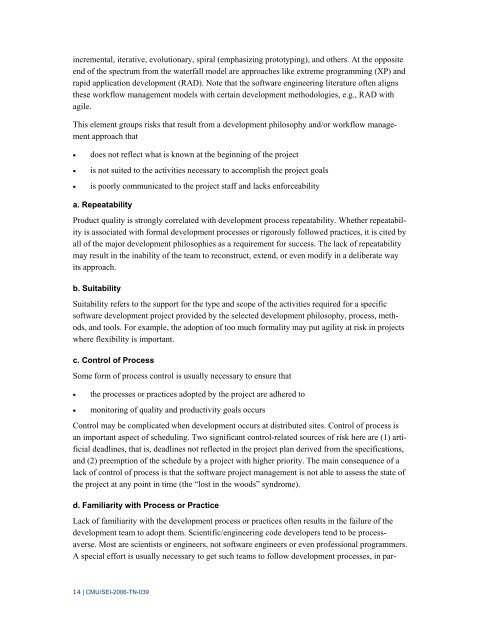A Proposed Taxonomy for Software Development Risks for High ...
A Proposed Taxonomy for Software Development Risks for High ...
A Proposed Taxonomy for Software Development Risks for High ...
You also want an ePaper? Increase the reach of your titles
YUMPU automatically turns print PDFs into web optimized ePapers that Google loves.
incremental, iterative, evolutionary, spiral (emphasizing prototyping), and others. At the opposite<br />
end of the spectrum from the waterfall model are approaches like extreme programming (XP) and<br />
rapid application development (RAD). Note that the software engineering literature often aligns<br />
these workflow management models with certain development methodologies, e.g., RAD with<br />
agile.<br />
This element groups risks that result from a development philosophy and/or workflow management<br />
approach that<br />
• does not reflect what is known at the beginning of the project<br />
• is not suited to the activities necessary to accomplish the project goals<br />
• is poorly communicated to the project staff and lacks en<strong>for</strong>ceability<br />
a. Repeatability<br />
Product quality is strongly correlated with development process repeatability. Whether repeatability<br />
is associated with <strong>for</strong>mal development processes or rigorously followed practices, it is cited by<br />
all of the major development philosophies as a requirement <strong>for</strong> success. The lack of repeatability<br />
may result in the inability of the team to reconstruct, extend, or even modify in a deliberate way<br />
its approach.<br />
b. Suitability<br />
Suitability refers to the support <strong>for</strong> the type and scope of the activities required <strong>for</strong> a specific<br />
software development project provided by the selected development philosophy, process, methods,<br />
and tools. For example, the adoption of too much <strong>for</strong>mality may put agility at risk in projects<br />
where flexibility is important.<br />
c. Control of Process<br />
Some <strong>for</strong>m of process control is usually necessary to ensure that<br />
• the processes or practices adopted by the project are adhered to<br />
• monitoring of quality and productivity goals occurs<br />
Control may be complicated when development occurs at distributed sites. Control of process is<br />
an important aspect of scheduling. Two significant control-related sources of risk here are (1) artificial<br />
deadlines, that is, deadlines not reflected in the project plan derived from the specifications,<br />
and (2) preemption of the schedule by a project with higher priority. The main consequence of a<br />
lack of control of process is that the software project management is not able to assess the state of<br />
the project at any point in time (the “lost in the woods” syndrome).<br />
d. Familiarity with Process or Practice<br />
Lack of familiarity with the development process or practices often results in the failure of the<br />
development team to adopt them. Scientific/engineering code developers tend to be processaverse.<br />
Most are scientists or engineers, not software engineers or even professional programmers.<br />
A special ef<strong>for</strong>t is usually necessary to get such teams to follow development processes, in par-<br />
14 | CMU/SEI-2006-TN-039
















